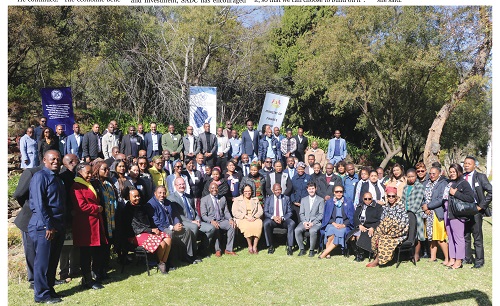By Thoboloko Ntšonyane
MASERU – The Southern African Development Community (SADC) has set its sights higher to propel itself to new heights of economic growth, development and integration.
The 16 member bloc has called for the enhanced cooperation amongst the Member States in order to achieve the much sought after regional integration.
These sentiments were expressed extensively at the recent launch of the ‘SADC Success Stories’, where the ‘Lesotho Success Stories’, volume 1 booklet was launched in Maseru.
SADC’s Acting Director of Industrial Development and Trade, Calicious Tutalife reiterated that SADC continues to deepen the integration aspirations of the region in various priority areas. Those he said include the strengthening communications in the region which he noted that it remains the Secretariat’s “main priority”, as expressed in the Regional Indicative Strategic Plan (RISDP) 2020-2030.
Reflecting on the ‘Lesotho Success Stories’ book, Tutalife hailed the event as marking a milestone towards strengthening the regional and national linkages and with a view to achieve the goal of “Taking SADC to The People”.
He added: “As we all are aware, SADC Belongs to the People and it is through initiatives such as SADC Success Stories that we will be able to create awareness among the citizens of this region, about the positive impacts of the SADC Regional Integration Agenda.
He continued: “The economic benefits expected from Regional Integration, as shown elsewhere around the world, include increased market size, improved intra-regional trade and investment flows, and increased transfer of technology and experience. However, over the years, it has become apparent that the citizens of the Member States are not fully aware of the existence of the various initiatives, protocols, programmes and projects which are aimed at facilitating better life for them. The SADC Success Stories are, thus, meant to communicate with the masses and enhance awareness about the positive impacts of these initiatives, protocols and agreements.”
He said the SADC Secretariat is encouraged by the fact that Lesotho has undertaken concerted efforts to ensure that SADC becomes visible at the national level adding that this comes at a time when, Lesotho has much to showcase on benefits it has reaped from the initiatives, protocols, and agreements at regional level.
The Acting Director of Industrial Development and Trade commended Lesotho for making strides in the implementation of the regional agenda towards trade and infrastructure that supports trade, cognizant that effective trade translates into economic growth, the Lesotho Revenue Authority (LRA) now known as Revenue Services Lesotho (RSL) implemented the Coordinated Border Management (CBM) project late in 2019 in accordance with the SADC Protocol on Trade, which boosts developments that improve trade between Member States.
“Through the Protocol on Finance and Investment, SADC has encouraged cross border financial inclusion for people. Lesotho was one of the first countries in the region to implement a Cross Border Money Transfer Project between itself and South Africa. Hailed as one of the cheapest cross-border products in the world, the Project has become a significant game-changer and a well-established formal channel of sending money from South Africa to Lesotho. The values have grown so big that policy makers would like to see this service digitized and replicated to other Member States.
“And finally, through the SADC Protocol on Shared Watercourses, which aims to foster closer cooperation among SADC Member States for protection, management, and use of shared watercourses in the region. Since 2000, the Lesotho government has embarked on the development of the Lesotho Lowlands Water Supply Scheme to ensure adherence and compliance to the human right of reliable access to clean water and sanitation,” he said.
The booklet features Lesotho’s six success stories including: the Coordinated Border Management which is also in line with SADC Protocol on Trade; Cross-border Money Transfer system; water for the Lesotho’s lowlands; Roof of Africa (the annual motorcycle competition); the Lesotho soil quality which contributes to food security and the web-based job portal, a platform where employers meet their potential workers.
Speaking at the auspicious event, the Minister of Finance and Development Planning, Dr Retšelisitsoe Matlanyane said the booklet is part of “writing our own history” adding that “we learn from it, so that we can choose to build on it”.
Dr Matlanyane said Lesotho recognizes that information dissemination contributes to good governance and accountability.
She said this booklet should assist in enhancing the SADC visibility, which will in turn stimulate collaboration and partnerships in the implementation of the SADC Agenda. The Minister stressed that “information is a tool that propels people to better understanding that leads to sound judgment and decision making”.
“We realised that other than some of us who are right at the center of the implementation of the SADC plans, programmes and projects, very little is known by the ordinary Mosotho about what Lesotho is doing under the auspices of SADC. Most, if not all of the initiatives that we are undertaking under SADC cannot immediately and easily be identified as regional initiatives. Hence the move to undertake the project to put together stories that would attest to the benefit and justify our membership to SADC.
In the past, she said Basotho knew SADC as synonymous with the military intervention that Lesotho experienced during the 1998 political riots or the support that the bloc is rendering to the country towards the ongoing National Reforms.
She underscored the need for the SADC stories to reach the people at grassroots saying they will prepare the summary of the booklet in vernacular.
“We [will embark] on this exercise to publicize SADC and the regional integration agenda in Lesotho; for Basotho,” she said.


